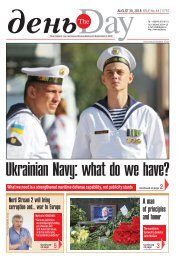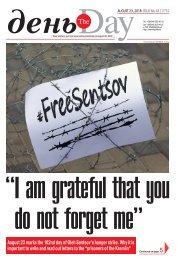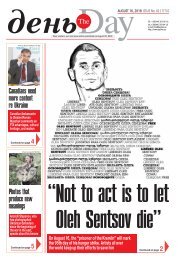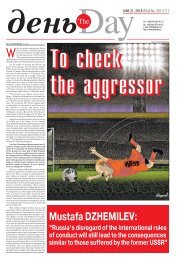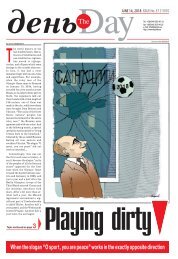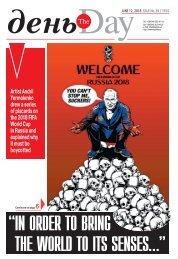#47_1-8
Create successful ePaper yourself
Turn your PDF publications into a flip-book with our unique Google optimized e-Paper software.
WWW.DAY.KIEV.UA<br />
CLOSE UP No.47 SEPTEMBER 20, 2018 5<br />
By Ivan KAPSAMUN,<br />
Valentyn TORBA, The Day<br />
Photos from Serhii POPKO’s<br />
Facebook page<br />
Sea of Azov Controversy<br />
Expert says that unless the Ukraine-Russia<br />
Friendship Treaty is renewed, the agreement<br />
on the Sea of Azov may become null and void<br />
Colonel General Serhii Popko,<br />
commander of the Ground Forces,<br />
wrote on Facebook recently that<br />
Ukraine has deployed additional<br />
troops and equipment in the<br />
direction of the Sea of Azov: “In response<br />
to Russia’s aggressive activities in the Sea<br />
of Azov, the General Staff of the Armed<br />
Forces of Ukraine has ordered<br />
reinforcements for the group of the Armed<br />
Forces, including Ground Forces in the<br />
direction of the Sea of Azov. Measures are<br />
being taken to keep the situation fully<br />
under control, secure support of the naval<br />
group and a reliable defense of the coast.<br />
The region is being placed under constant<br />
control by joint brigades and territorial<br />
defense by missile, artillery, and military<br />
aviation units. I had the honor of presenting<br />
government decorations to officers and<br />
the men of one such brigade on combat duty<br />
in the region bordering the Sea of Azov.”<br />
The day before, it became known that<br />
the Lubny and Kremenchuk armored artillery<br />
boats were deployed on the Sea of<br />
Azov to enhance Ukrainian naval presence<br />
there. These measures actually point to the<br />
implementation of a complex of measures<br />
earlier adopted by the National Security<br />
and Defense Council (RNBO), aimed at defending<br />
Ukraine’s national interests in the<br />
Black Sea, the Sea of Azov, and the Kerch<br />
Strait where Russia is hindering maritime<br />
transit. Since April 2018, Russian<br />
warships have been detaining foreign ships<br />
headed for the seaports of Berdiansk and<br />
Mariupol as they passed through the Kerch<br />
Strait. Russia’s actions contravene an international<br />
treaty under which the Sea of<br />
Azov is an internal sea for Ukraine and<br />
Russia and thus open for the free navigation<br />
of both countries.<br />
Fortunately, the Ukrainian administration<br />
has started responding to a critical<br />
situation that developed a long time ago<br />
and which has for the past six months been<br />
lamented by expert Andrii Klymenko and<br />
Admiral Ihor Kabanenko. Back in 2014,<br />
the Ukrainian Navy lost some 70 percent<br />
of vessels and at long last, now into the<br />
fifth year of war, the President “instructed<br />
to work out the Maritime Doctrine of<br />
Ukraine” after a recent RNBO meeting. It’s<br />
a shame it took so long and such belated<br />
measures can only encourage Russia to continue<br />
its aggression against Ukraine.<br />
The Ukraine-Russia agreement on cooperation<br />
in the use the Sea of Azov and<br />
Kerch Strait, signed in 2003, is still effective.<br />
It has five articles that read:<br />
— The Sea of Azov and the Kerch<br />
Strait are historically internal waters of the<br />
Russian Federation and Ukraine.<br />
— The Sea of Azov must be delimited<br />
by the state border in accordance with<br />
the Agreement signed by both Parties.<br />
— Mercantile vessels and other state<br />
non-commercial vessels flying the flags of<br />
the Russian Federation and Ukraine have<br />
free navigation in the Sea of Azov and the<br />
Kerch Strait. Mercantile vessels flying<br />
the flags of third countries can enter the Sea<br />
of Azov and pass through the Kerch Strait<br />
provided they are headed for a Russian and<br />
Ukrainian port or are on the way back.<br />
— Military and other vessels of third<br />
countries that are used for non-commercial<br />
purposes can enter the Sea of Azov and pass<br />
through the Kerch Strait provided they are<br />
on a visit or invited or allowed to enter a<br />
port of either of the Parties with the<br />
knowledge and consent of the other Party.<br />
— Disputes between the Parties in conjunction<br />
with the interpretation and application<br />
of this Agreement shall be settled<br />
by consultations, negotiations, and by using<br />
other peaceful means as chosen by the<br />
Parties.<br />
There are two controversial statements<br />
which will decide whether this<br />
treaty will remain effective. Olena Zerkal,<br />
Deputy Minister of Justice of Ukraine, declared<br />
that Kyiv does not intend to terminate<br />
the treaty with Russia. Borys Babin,<br />
the President’s Permanent Representative<br />
to Crimea, said his office is preparing<br />
documents for the possibility of abrogating<br />
the agreement. At this it is worth to recall<br />
the circumstances in which Ukraine<br />
agreed to sign the agreement in 2003.<br />
In an interview with Channel Ukrlife.TV,<br />
Ihor Smeshko, head of SBU in<br />
2003-05, said: “The Kremlin realized that<br />
Ukraine would offer resistance [e.g., the<br />
Tuzla conflict in 2003 – Ed.]. The signing<br />
of the Sea of Azov Agreement was a compromise<br />
of sorts. It was a political compromise<br />
meant to calm Moscow that was<br />
worried at the time about access to the Sea<br />
of Azov, especially for NATO warships. In<br />
2003, the Verkhovna Rada passed the bill<br />
on the Concept of National Security and<br />
Defense. For the first time Ukraine’s fullfledged<br />
participation in the Euro-Atlantic<br />
security structures – NATO and EU – was<br />
legislatively confirmed as a strategic objective.<br />
It is also true that Russia was then<br />
actively knocking on NATO doors. In his<br />
well-known speech in Rome, Putin paid<br />
THE GENERAL STAFF OF THE ARMED FORCES OF UKRAINE HAS ORDERED<br />
REINFORCEMENTS FOR THE GROUP OF THE ARMED FORCES, INCLUDING<br />
GROUND FORCES IN THE DIRECTION OF THE SEA OF AZOV, AS PART OF A<br />
COMPLEX OF MEASURES TO DEFEND THE NATIONAL INTERESTS IN THE REGION<br />
compliments to NATO. He also actively<br />
worked on Russia’s EU membership.<br />
Therefore, Ukraine’s tactic served its national<br />
interests under the circumstances.<br />
After Russia’s calculated maneuvers<br />
failed, an agreement on the Sea of Azov<br />
was quickly drafted. It was done in order<br />
to assure the Kremlin that no NATO vessels<br />
would be in the Sea of Azov, acting as<br />
a possible threat to Russia, as under the<br />
agreement, entry of foreign ships was<br />
possible only with the knowledge and consent<br />
of the signatories. In other words,<br />
Russia now had the right to veto such entry<br />
to the Sea of Azov. It was a compromise<br />
at the time.”<br />
What about now? According to Ihor<br />
Smeshko, “to an extent, we are free of our<br />
obligations after the start of Russia’s aggression<br />
against Ukraine and its annexation<br />
of Crimea. The way I see it, this<br />
agreement makes no sense. Under it, we<br />
cannot adequately defend our national interests<br />
in the Sea of Azov and Kerch<br />
Strait; it denies us the influence of international<br />
law under the UN Convention on<br />
the Law of the Sea (1982). Over 172 countries<br />
joined this convention, among them<br />
Russia. If we terminated this agreement<br />
with Russia – and we have every moral, legislative,<br />
and political right to do so – we’d<br />
be under the jurisdiction of international<br />
law under the Convention on the Law of the<br />
Sea. We would automatically receive tangible<br />
privileges, including 20 miles of territorial<br />
waters and 24 miles of the exclusive<br />
economic zone. Besides, the convention<br />
contains all the procedures for settling disputes<br />
on the sea, involving international institutions<br />
and envisaging sanctions.”<br />
Why hasn’t Ukrainian diplomacy<br />
considered this effective mechanism of returning<br />
this country to the protection offered<br />
under international law?<br />
Andrii Klymenko, editor-in-chief,<br />
https://www.blackseanews.net, told The<br />
Day: “The Foreign Affairs Maidan Group<br />
has long been reiterating that the agreement<br />
on the Sea of Azov between Russia<br />
and Ukraine should be either terminated<br />
or suspended. Lawyers would know<br />
what to suspend and what to abrogate.<br />
We need a frontier on the Sea of Azov.<br />
We have none. As a result of this inappropriate<br />
agreement, the frontier is set<br />
along the line of the surf on the beach,<br />
that is, along the coast where the land<br />
ends. This is absolutely understandable,<br />
but there is the curious stand taken by the<br />
deputy foreign minister. It boils down to<br />
the allegation that everything is OK on<br />
the Sea of Azov and that the media are<br />
making a mountain out of a molehill – a<br />
finger pointed in our direction, considering<br />
that the Foreign Affairs Maidan<br />
has been carrying regular reports on the<br />
situation in the Sea of Azov. Only the military<br />
and Borys Babin, the President’s<br />
representative to Crimea, an expert on<br />
the law of the sea, have taken a stand similar<br />
to ours. The Ministry of Foreign Affairs<br />
has reacted to the contrary. Russia,<br />
in turn, objected to the dominance of the<br />
Law of the Sea in regard to the Sea of<br />
Azov, referring to that agreement with<br />
Ukraine. Indeed, back in 2003, the signatories<br />
somehow left the Sea of Azov<br />
and Kerch Strait out of the jurisdiction<br />
of the Law of the Sea. The preamble<br />
reads that the agreement is based on<br />
the Ukraine-Russia Friendship Treaty. In<br />
other words, if the Friendship Treaty is<br />
not renewed, the agreement on the Sea of<br />
Azov may become null and void.”<br />
By Vladyslava SHEVCHENKO<br />
Today one can instantly immerse<br />
oneself in past or current realities.<br />
All it takes is a special headgear or<br />
a pair of glasses, and then one is off<br />
on an exciting trip and in for strong<br />
emotions.<br />
Sounds simple, but trips to the past also<br />
take courage when reliving especially<br />
tragic events. A team of young Ukrainian<br />
IT enthusiasts founded New Cave Media<br />
(newcavemedia.com) [an immersive storytelling<br />
studio that delivers 360°/VR solutions<br />
to commercial clients worldwide –<br />
Ed.]. They weren’t afraid of the challenge<br />
and selected February 20, currently known<br />
as Euromaidan.<br />
● IMMERSION IN REALITY<br />
As usual, one puts on a headgear – VR<br />
helmet – and finds oneself back in 2014, on<br />
the 20th day of February (tagged by media<br />
as Black Thursday). However, this is not<br />
the usual kind of computer-generated reality.<br />
This is what really happened in<br />
Ukraine. Winter. Maidan. Instytutska St.<br />
Scared people around. As back then, one is<br />
hard put to figure out what’s happening.<br />
Emotions are hard to hold in check. Pain<br />
and anxiety. One can remember what happened<br />
then, every minute of it, and the<br />
ever-present fear. Hard to endure but<br />
very important. Forgetting important<br />
pages in our history eventually leads to<br />
tragic consequences, like the ones that<br />
occurred almost five years ago.<br />
This virtual reality project is especially<br />
significant now that Instytutska St.<br />
is to be revamped. In other words, our<br />
WhathappenedonBlackThursday,February20,2014?<br />
Virtual reality Project “Aftermath VR: Euromaidan” launched in Kyiv<br />
children and grandchildren won’t see<br />
the place where one of the most hair-raising<br />
tragedies in Ukraine’s latter day history<br />
took place. When you visit it, you<br />
can’t help but feel the tears and the pain<br />
in your heart. You realize that the heroes<br />
of the Heavenly Hundred sacrificed their<br />
lives for a better future for you and your<br />
posterity.<br />
What happened on that Black Thursday<br />
in downtown Kyiv remains a<br />
heartrending memory, but it is part of our<br />
history. The reconstruction of those events,<br />
using the latest IT developments, offers a<br />
chance to leave these memories alive for future<br />
generations.<br />
Each visitor spends 15-20 min. with<br />
the VR glasses/helmet on – and relives that<br />
day. This is truly a unique project in our<br />
world which is teeming with visual data.<br />
People feel that they are amidst the events,<br />
that everything is real, rather than watch-<br />
Photo by Ruslan KANIUKA, The Day<br />
ing a movie or TV serial. This provides a<br />
considerably higher degree of empathy.<br />
● REFUTING MYTHS<br />
IT team members say they were outraged<br />
by the campaign of disinformation<br />
launched in the aftermath of events in<br />
February. Project co-founder Serhii POLE-<br />
ZHAKA: “This wasn’t the first or last instance<br />
of the Russian propaganda machine<br />
coming up with thousands of versions of<br />
what had actually happened. Every effort<br />
was made to discourage people to learn the<br />
truth. We were present there, so we held our<br />
view on the situation. We wanted to help the<br />
activists and eyewitnesses share the truth<br />
about what had taken place on that street.”<br />
Project “Aftermath VR: Euromaidan”<br />
allows every viewer to follow the protesters<br />
step by step and the narrator explains<br />
about the mass shootings on February 20.<br />
There are documentary footages, 360° interviews<br />
with eyewitness, and a Euromaidan<br />
exhibit. Some of these artifacts are<br />
courtesy of the Revolution of Dignity Museum’s<br />
Heavenly Hundred Memorial.<br />
The photos are perhaps the most visceral.<br />
You see yourself standing on an ordinary<br />
Kyiv street, in front of a photo display,<br />
but once you aim the “pointer” at a<br />
photo, you can see what took place here only<br />
several years ago. Pitched street battles,<br />
blood-covered protesters, sheer violence.<br />
A number of photo artists from across<br />
Ukraine contributed to the project, among<br />
them Project Coordinator Oleksii FUR-<br />
MAN, a veteran contributor to Den/The<br />
Day. Back in 2010, he was the first to vie<br />
in and win the Editors’ International<br />
Photo Contest in the children’s classification.<br />
Several years later, he won the<br />
contest in the adult standing with his series<br />
of photos “Life After [War]<br />
Wounds.” In 2017, Den’s Summer School<br />
of Journalism students were among the<br />
first to learn about this large scale project<br />
from the author.<br />
● PROJECT SPECIFICS<br />
The video was made using photogrammetry,<br />
a 3D technique that uses<br />
photography in surveying and mapping to<br />
ascertain measurements between numerous<br />
objects. In Ukraine, this scope is reflected<br />
in virtual reality for the first time<br />
in history. This technique allows the viewer<br />
to “feel” the cobblestones on virtual Instytutska<br />
St. under his/her feet, and<br />
“walk” up and down the street.<br />
The IT team faced difficulties, of<br />
course. Oleksii Furman: “We chose a very<br />
complicated site for scanning. There were<br />
many structures topped with glass. Also,<br />
this was a downtown street, with many people<br />
and cars on weekdays. On weekends, the<br />
situation was a little better, but there were<br />
frequent public events. We had to work in<br />
the morning and on weekends, when most<br />
people were at home. We worked in September,<br />
October, and November. There<br />
was no scanning when there was snow – or<br />
when the greenery was abundant, as it is<br />
now. Back on February 20, Instytutska St.<br />
was bare of leaves and grass.”<br />
Read more on our website






